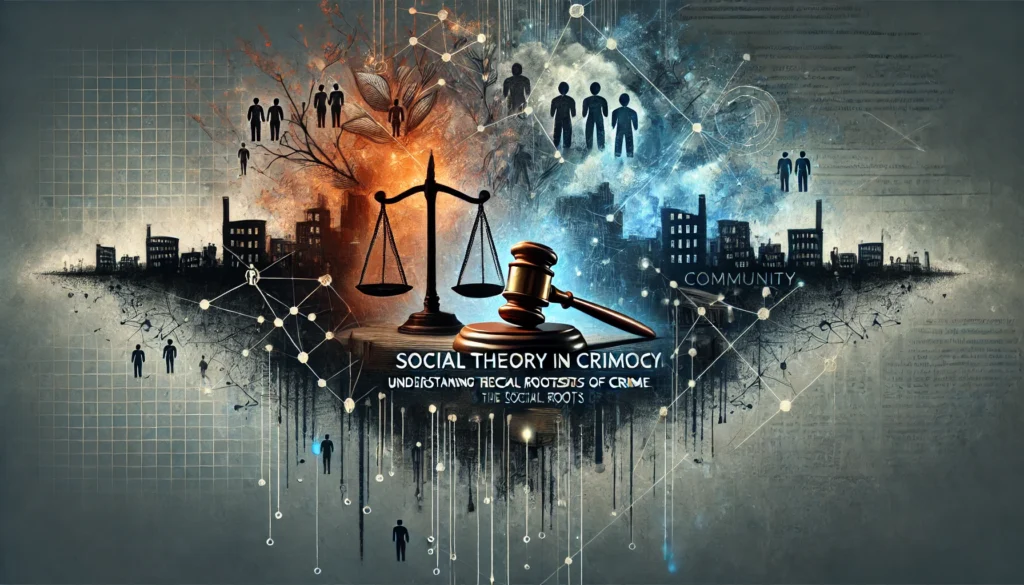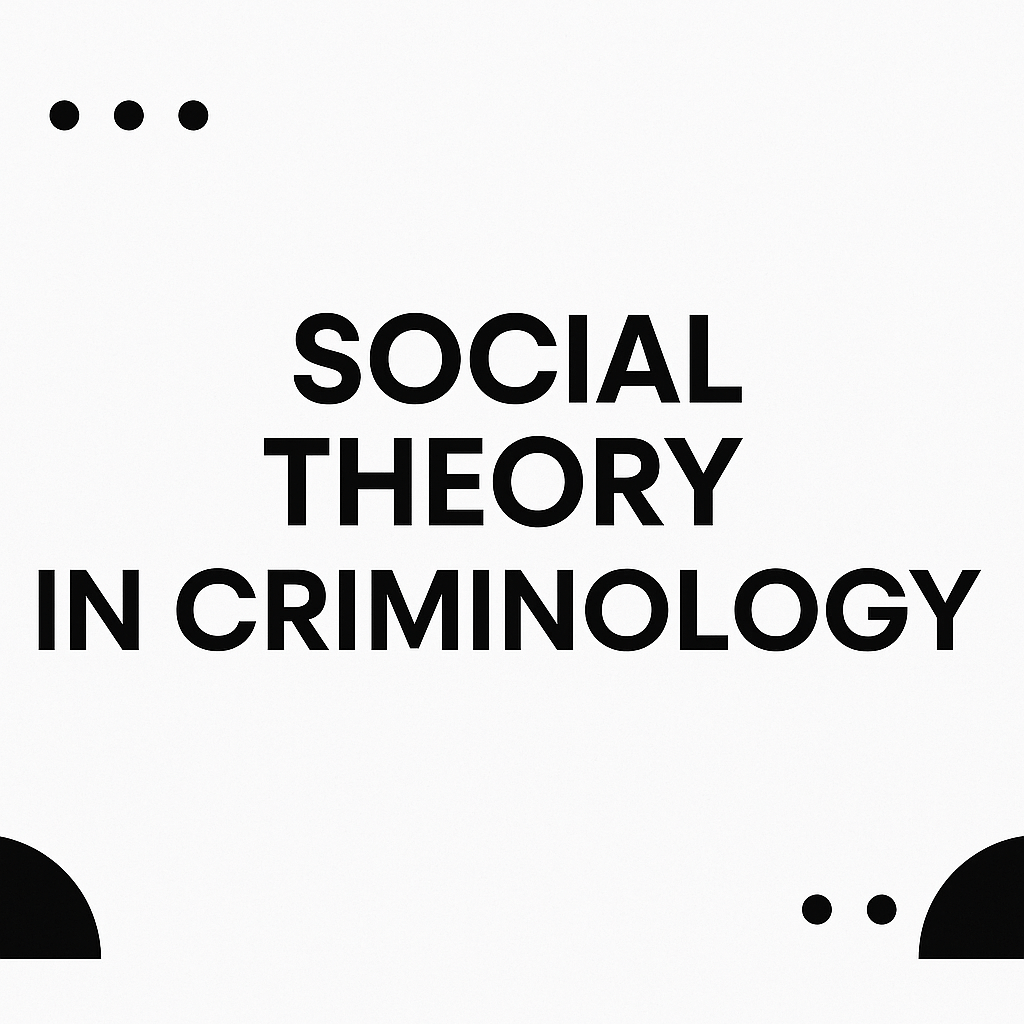Introduction
Social theory in criminology provides a framework for understanding how social structures, relationships, and cultural norms influence criminal behavior. By exploring the intersections of society and crime, social theories aim to explain why individuals or groups deviate from societal norms and engage in unlawful acts.
Understanding the roots of criminal behavior is a complex endeavor that requires more than just examining individual choices. Social theories offer a lens through which criminologists can observe the broader societal influences that contribute to deviance. These theories not only uncover patterns in criminal conduct but also guide policymakers, educators, and law enforcement in developing more effective responses to crime. Furthermore, social theory in criminology bridges the gap between macro-level structures—like institutions and economic systems—and micro-level behaviors, shedding light on how social environments shape personal decisions.
The Role of Social Theory in Criminology
Definition and Purpose
Social theory investigates the relationship between societal dynamics and human behavior. In criminology, it emphasizes how social conditions such as poverty, inequality, or marginalization contribute to criminal activity.
These conditions are often deeply rooted in historical and systemic inequities, making criminal behavior not merely a consequence of individual morality but a reflection of broader social dysfunction. By recognizing crime as a symptom of structural failure, social theories challenge the notion that punishment alone can solve criminal issues. Instead, they advocate for social reforms and equitable policies that address the root causes of deviance.
Historical Context
The use of social theory in criminology dates back to the 19th century, with sociologists like Émile Durkheim and Robert Merton laying the foundation for understanding crime as a social phenomenon rather than solely an individual issue.
Durkheim’s work on anomie introduced the idea that when societal norms break down, individuals may feel disconnected from collective values, leading to deviance. Merton expanded on this concept by linking it to the American Dream, arguing that when legitimate means to success are blocked, people resort to alternative—often illegal—methods. This historical evolution marked a shift in criminology from biological and psychological models toward sociological explanations, setting the stage for modern theories that continue to evolve with new research and societal changes.
Key Social Theories in Criminology
Strain Theory
Developed by Robert K. Merton, strain theory argues that societal pressures to achieve success, combined with limited opportunities, push individuals toward criminal behavior. It highlights how economic disparity and lack of resources can lead to deviance.
Strain theory is particularly relevant when analyzing juvenile delinquency. Young people facing barriers to educational and economic success often turn to alternative routes—such as theft, drug dealing, or gang involvement—as a way to fulfill societal expectations. The pressure to “make it” in society without the necessary support systems intensifies the risk of deviance during adolescence, a critical period of identity formation.
This theory has significantly influenced public policy, particularly in areas like education, employment, and urban development. Programs aimed at reducing strain, such as job training initiatives, financial aid for students, and community centers, have been developed to offer legitimate alternatives to crime. By addressing opportunity gaps, policymakers aim to decrease the structural tension that fosters deviance.
Social Disorganization Theory
Clifford Shaw and Henry McKay proposed this theory, emphasizing how crime thrives in communities with weak social institutions and high levels of residential instability. It links crime rates to neighborhood characteristics rather than individual traits.
Research grounded in social disorganization theory has consistently shown that urban neighborhoods with high levels of poverty, transient populations, and decaying infrastructure experience elevated crime rates. In such areas, social bonds are often weakened, making it difficult for residents to exert informal social control or cooperate with law enforcement.
Community cohesion plays a crucial role in mitigating crime. Neighborhoods with strong networks of trust and shared values tend to resist the influence of gangs and criminal subcultures. This has inspired urban development projects that prioritize not just physical infrastructure but also social capital—such as encouraging local leadership and participatory governance.
Labeling Theory
Introduced by Howard Becker, labeling theory examines how societal reactions to deviant behavior shape an individual’s identity. Once labeled as a “criminal,” a person might internalize this label and engage further in unlawful activities.
Labeling can initiate a self-fulfilling prophecy, where the individual accepts the imposed identity and continues engaging in deviance. For instance, someone branded as a delinquent during adolescence may face exclusion from educational opportunities and social groups, reinforcing their alienation and dependence on deviant subcultures.
Labeling theory also raises critical concerns about racial and ethnic bias in criminal justice systems. Minority populations are disproportionately labeled as deviant, which exacerbates social inequalities and perpetuates systemic discrimination. This insight has prompted discussions on the need for bias-free policing and judicial reform.
Differential Association Theory
Edwin Sutherland’s theory focuses on the idea that criminal behavior is learned through interactions with others. If individuals associate with peers who normalize crime, they are more likely to engage in similar behaviors.
This learning occurs through communication within intimate social groups where attitudes, techniques, and justifications for crime are passed on. It’s not just exposure to crime that matters, but the frequency, duration, and emotional intensity of those relationships. This explains how gangs or delinquent peer groups play a major role in perpetuating criminal values across generations.
While Sutherland originally emphasized face-to-face interaction, modern interpretations of the theory consider the influence of online environments. Social media and internet forums can facilitate the learning of deviant behavior by connecting individuals with criminal ideologies, creating virtual subcultures that reinforce unlawful conduct.
Conflict Theory
Inspired by Karl Marx, conflict theory views crime as a result of power struggles and inequality. It posits that laws are tools used by dominant groups to maintain their control over marginalized populations.
Conflict theory suggests that behaviors common among lower-income groups are more likely to be labeled as criminal, while white-collar crimes often receive lenient treatment or are overlooked altogether. This disparity reveals how legal systems may reflect and enforce class hierarchies rather than delivering impartial justice.
The theory also sheds light on political dissent and resistance. Protest actions, strikes, or civil disobedience may be criminalized not because they are inherently harmful, but because they challenge the status quo. In this sense, crime becomes a form of social resistance—a message from those excluded from mainstream power structures.

Applications of Social Theories in Crime Prevention
Community Programs
Social disorganization theory has inspired initiatives aimed at strengthening community ties, such as youth mentorship programs, community policing, and neighborhood revitalization projects.
Sustainable crime prevention requires long-term investment in community infrastructure. Initiatives that support public housing improvements, local business development, and access to mental health services help build environments that discourage crime. These strategies rely on community engagement and leadership, ensuring that residents take active roles in shaping safer neighborhoods.
Cities like Chicago and Los Angeles have implemented programs rooted in social disorganization theory. For example, the Chicago Area Project focuses on youth leadership, conflict mediation, and grassroots neighborhood development. These localized efforts have shown measurable reductions in gang activity and youth arrests over time.
Policy Changes
Policies addressing economic inequality, education access, and job creation are rooted in strain theory’s understanding of crime as a response to social pressures.
Governments have adopted legislative frameworks to reduce strain by increasing social mobility. Examples include increasing the minimum wage, expanding access to higher education, and providing tax incentives for businesses that hire individuals from marginalized communities. These policies aim to close the gap between cultural goals and available means to achieve them.
Education is central to reducing criminal tendencies, particularly when school systems provide equitable resources, counseling, and career guidance. Strain theory highlights the importance of removing barriers within education systems that disproportionately affect low-income or minority students, who might otherwise turn to crime as a means of success.
Rehabilitation Efforts
Labeling theory encourages rehabilitation programs that focus on reintegrating offenders into society without stigmatizing them.
Diversion programs and restorative justice initiatives offer non-carceral responses to crime, particularly for first-time and low-risk offenders. These alternatives reduce the damaging effects of criminal labeling and instead focus on accountability, victim-offender dialogue, and community service, helping individuals avoid lifelong criminal identities.
Successful rehabilitation depends heavily on social support systems. Programs offering job placement, housing assistance, and mental health care help former inmates rebuild their lives and reduce recidivism. By removing the stigma of criminal records, these efforts align with labeling theory’s goal of preventing the reinforcement of deviant identities.
Critiques of Social Theory in Criminology
While social theories offer valuable insights, they also face criticism. For example:
Oversimplification: Some argue that these theories underestimate individual agency and psychological factors.
Contextual Limitations: Theories may not account for cultural variations or global influences on crime.
Lack of Empirical Evidence: Certain aspects, like labeling theory, have been criticized for insufficient empirical support.
Critics argue that by focusing exclusively on social structures, these theories often overlook individual psychological traits such as impulse control, personality disorders, or trauma history. A more holistic approach to criminology would integrate both sociological and psychological dimensions to better understand the complexity of human behavior.
Globalization has introduced new variables into criminological analysis—such as cybercrime, transnational crime syndicates, and migration-related issues—that some traditional social theories were not designed to address. Adapting these theories to modern contexts is essential to ensure their continued relevance.

Conclusion
Social theories in criminology highlight the critical role of societal factors in shaping criminal behavior. By addressing structural inequalities and fostering supportive social environments, these theories provide actionable insights for reducing crime and building healthier communities.
Despite critiques, social theories remain indispensable for understanding and combating crime in a rapidly changing world. They offer a macro-level perspective that complements other approaches and remind policymakers that effective crime prevention goes beyond policing and punishment—it requires building just, inclusive societies.
The true value of social theory lies in its application. Whether through urban planning, education reform, or judicial change, these frameworks provide a roadmap for addressing root causes rather than symptoms. As criminology evolves, integrating empirical research with theoretical insight will be key to crafting more humane and effective justice systems.

